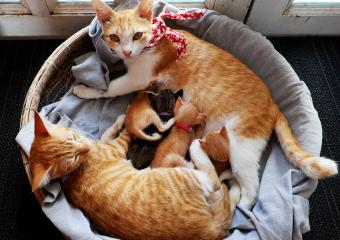
You've probably heard the term "runt" used for any small kitten, but what exactly is the runt of the litter, and how can you tell if your kitten is the runt? There are six qualities you should look for to identify the runt of the litter. Most runts thrive and grow into strong, healthy cats, but they do need quite a bit of care during their first few weeks of life. Use our runt kitten growth chart to make sure your little one is gaining weight appropriately.
What Is a Runt Kitten?
The runt of a litter is the one who's significantly weaker and smaller than the rest of their littermates. Runt kittens are born underdeveloped and often have a hard time thriving, so they need special care for the first four to eight weeks of life. Most runts do great and go on to lead full, long lives, but unfortunately, some succumb to fading kitten syndrome and don't make it.
Why Are There Runts?
There are a lot of theories about why runts even exist. Some people suggest that it's because a cat's uterus is a Y-shape, so the kitten in the middle of the Y doesn't get as much nourishment as the rest, whereas many experts say it has more to do with the embryo's implantation within the uterus. Whatever the case, these kittens are born underdeveloped.
Does every litter have a runt? Nope! In fact, most litters don't have a runt because all the kittens are born equally healthy.
How to Tell if a Kitten Is a Runt
Are you trying to figure out if your litter has a runt or if your kitten was the runt of their litter? There are a few qualities you can look for that point to "yes."
- The kitten is really small. Runts are usually a lot smaller than their littermates.
- The kitten won't gain weight. Not only are runt kittens tiny, but they don't gain weight at the same rate as the other kittens. Some runts even lose weight.
- The kitten is weak. Runts won't have the same energy level as their littermates. They won't move around as much or make noises as readily as the others.
- The kitten won't suckle. Runts have trouble eating. They might be too weak to suckle on their mother or a bottle, or they could have a medical issue, such as a cleft palate, that prevents them from suckling correctly.
- The kitten appears sick. Runts often show signs of illness, like difficulty breathing, diarrhea, or discharge from the nose.
- The kitten is abandoned by the mother cat. Often the mother cat will instinctively reject the runt because she knows there's something wrong with it. She won't clean it or tend to it in the same way as the other kittens.
If a kitten is just smaller than the rest, that doesn't necessarily mean they're the runt. Litters can have different fathers (fun fact: it's called "superfecundation"), so a kitten might look slightly different.
Runt Kitten Growth Chart
Runt kittens rely on their mother for warmth and nourishment, but if their mother has rejected them or if they are having difficulty eating, you'll need to step in. Bottle-feed your kitten and weigh them at the same time every day to ensure they're gaining weight. This runt kitten growth chart can be used to keep your kitten on track.
| Kitten Age | Weight Target |
| 1 week | 5 to 8 ounces |
| 2 weeks | 6 to 12 ounces |
| 3 weeks | 8 to 15 ounces |
| 4 weeks | 12 ounces to 1 pound |
| 5 weeks | 14 ounces to 1.4 pounds |
| 6 weeks | 1 to 1.5 pounds |
| 7 weeks | 1.25 to 2 pounds |
| 8 weeks | 1.5 to 2.5 pounds |
| 12 weeks | 2 to 3 pounds |
| 16 weeks | 4 to 4.5 pounds |
Do runt kittens stay tiny forever? Some can stay smaller than their littermates, whereas others grow up to be the same size.
Runt Kitten Personality
Runt kittens don't have specific personality traits, but a pet's upbringing definitely influences their temperament. Because a runt gets a lot more human interaction and handling than other kittens, they'll probably enjoy being picked up a lot more.
They're also usually very loving and affectionate. But on the other hand, they might be more demanding than other kittens because they're used to having your full attention. It depends a lot on how they were raised. If a kitten is rejected by their mother and you rescue them later, they may have attachment issues or behavioral problems. Extra love usually solves the problem, though.
Health Issues Associated with Being the Runt
Kittens who are born underdeveloped can be at risk for health issues throughout kittenhood and later on in life. Some of these include:
- Viral infections
- Parasites
- Dwarfism
- Cleft palate
- Heart problems
- Congenital defects
These Tiny Kittens Can Make Great Pets
If you find yourself with the runt of the litter, you're in for a busy several weeks, but the effort may be well worth it. Run kittens can thrive as well as any other member of the litter with careful nursing and a whole lot of TLC. Keep your runt warm, clean, and well-fed, and they may just reward you with several years of companionship.







